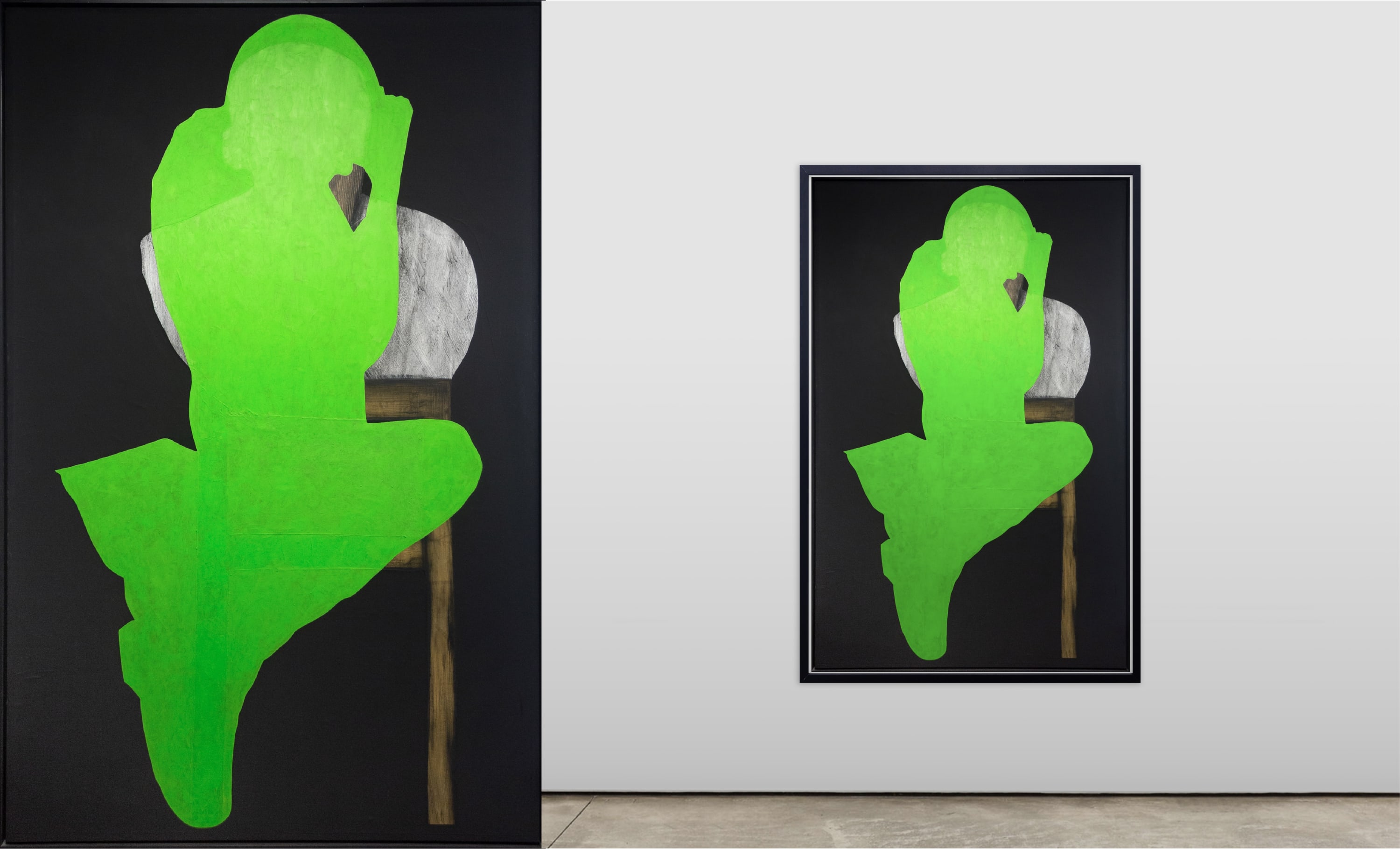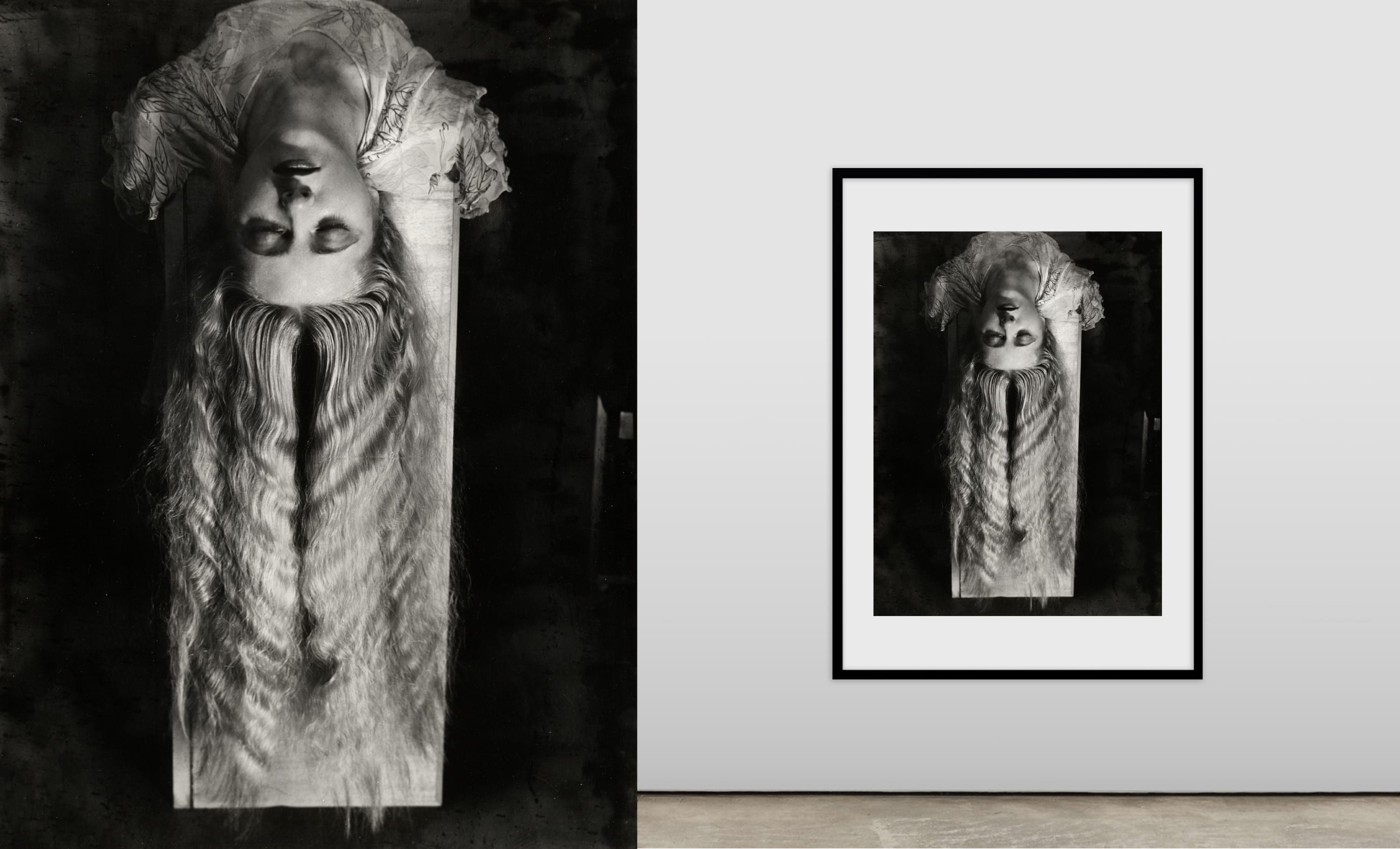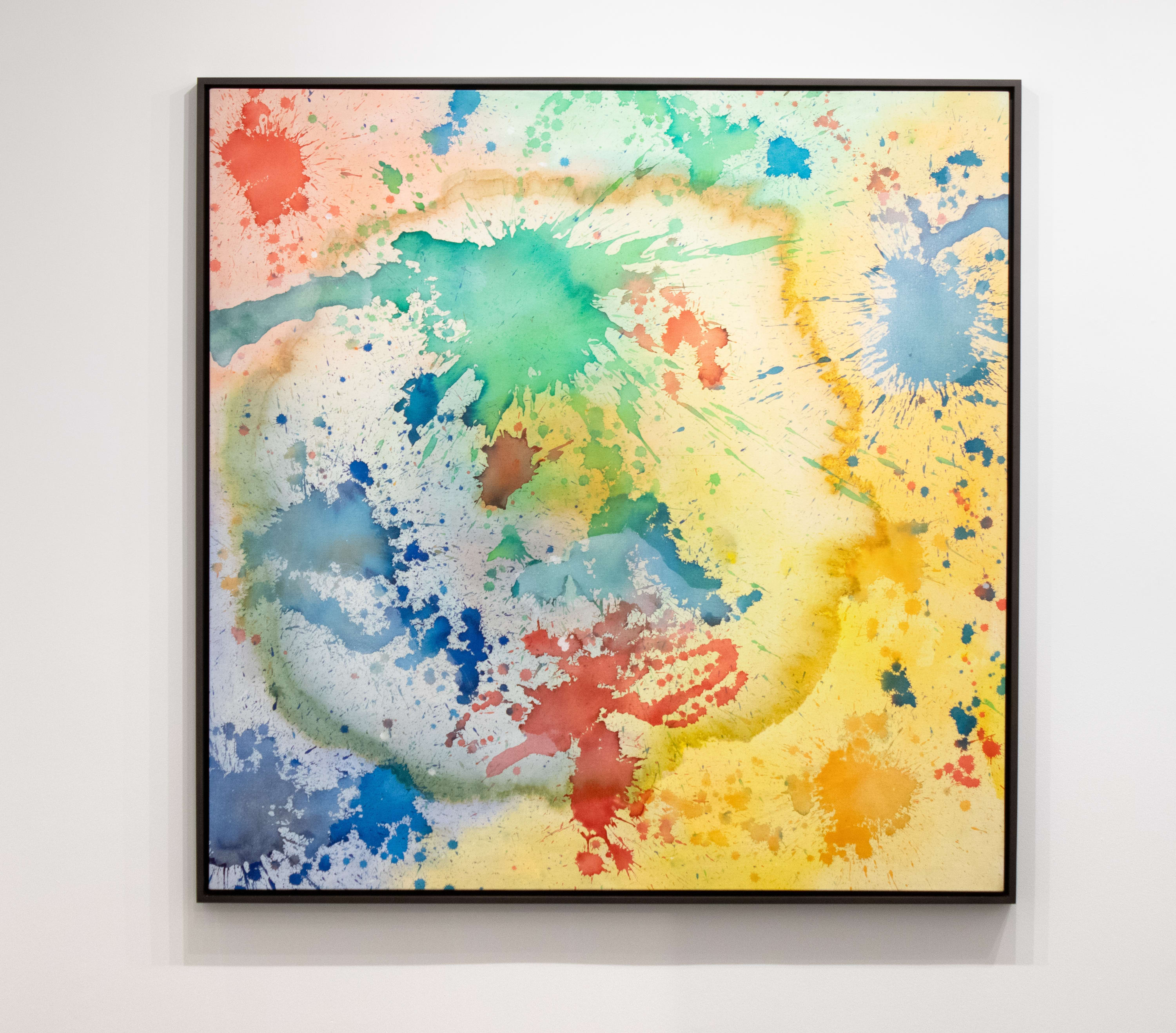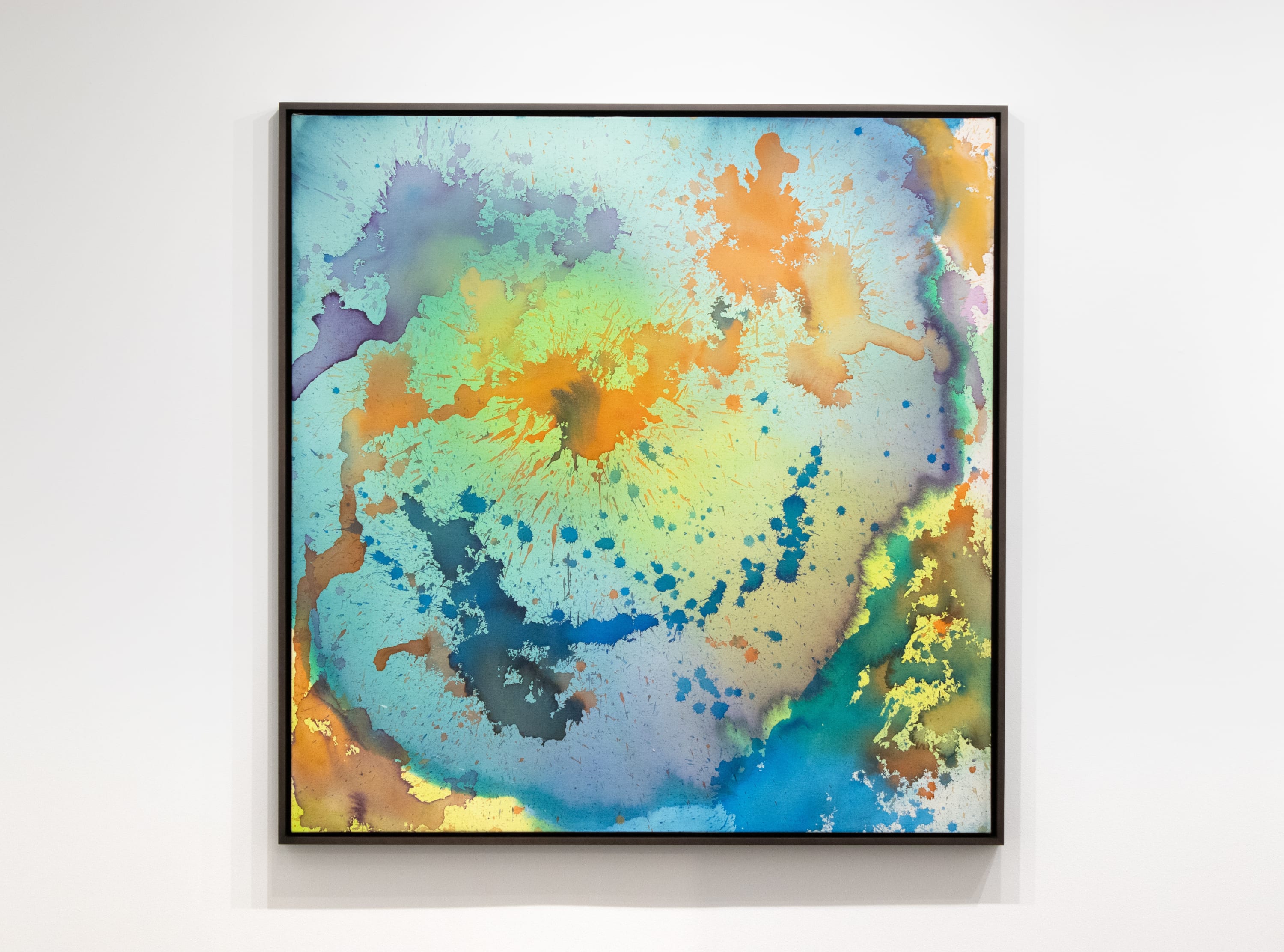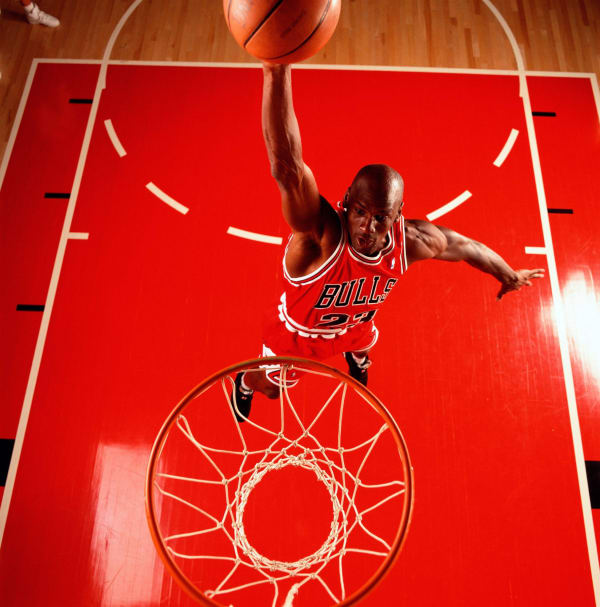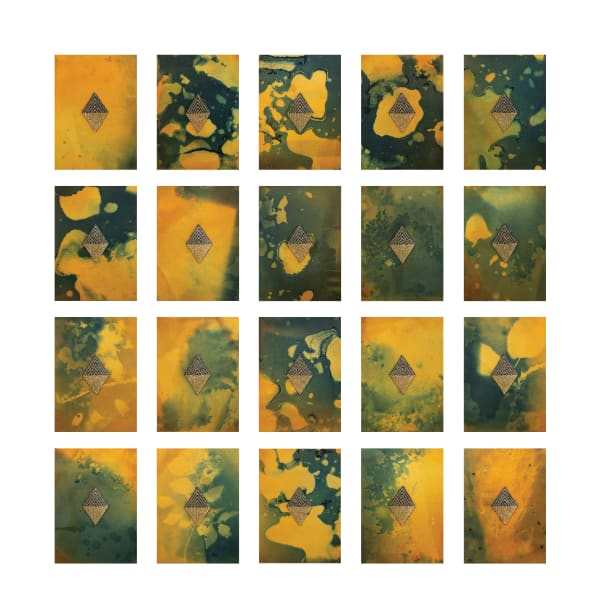-

Alfred Leslie (1927-2023)
Near Gallup, New Mexico (from 100 Views Along the Road), 1981
Each signed, titled, and dated with Oil & Steel Gallery and Richard Bellamy Stamps and Well Monceau labels on frame backing
Set of four watercolors on paper
18 x 24 in (45.7 x 61 cm)
Literature:
Leslie, A. (1988). Alfred Leslie, One Hundred Views Along the Road.
-
Created between 1981 and 1983, Alfred Leslie (1927-2023) made 100 Views using only a drawing pad and pencil, briefly sketching vague impressions of his surroundings from the front seat of his Ford. The series would develop into a complete entity that captures the “movement, atmosphere, and especially light” of the American landscape. Some locations get more than one view, showcasing the sequence of light as the sun shifts over the ocean in California or how the full moon appears in Oklahoma. Formally, Leslie achieves incredible depth and luminosity through his use of black, white, and greyscale. Black is used not to depict the absence of color but all the colors at once; it is both a receptor and refractor of light. Each work is also marked by a thick white band at the bottom of the paper, which Leslie identifies as the “earth not in view but as a given. The ground you know you are standing on as you look ahead. Earth as ground, ground as ground, base, surface of the paper”. Through the balance of carefully crafted black-and-white space, Leslie explores the Japanese concept of Nōtan. This principle proposes that “there can be an eternal unchanging response to the certain beauty of just so much white to just so much black.”
The title 100 Views Along the Road alludes to the rich historical series of narrative images by Hiroshige, One Hundred Famous Views of Edo. Like the Japanese ukiyo-e master, Leslie has channeled scenes that are somewhat recognizable, though not entirely renowned, and has quietly undermined this familiarity through a series of bold formal devices. Apart from the technical profundity of this work, 100 Views is, at its emotional center, “about being on the road, in the fast lane, not about this or that place, dawn or night, rain or snow, so much as about being in a car and going”. The watercolors are less about being true to the actual site, as they were for Hiroshige’s scenes of Edo, and more about translating the feeling of a place, a moment, an experience. The road has long held a mythic place in the American psyche, which connects everyone who has traversed the American highway behind the wheel and wondered at the definitive landscape surrounding them.
Painter and filmmaker Alfred Leslie (1937 - 2023), a monumental figure in the history of Modern Art, was born in the Bronx, New York. Emerging in the late 1940s as both an experimental filmmaker and a second-generation Abstract Expressionist painter, Leslie quickly garnered acclaim for his paintings. His breakthrough came with the Kootz Gallery exhibition, New Talent, 1950 - curated by Clement Greenberg and Meyer Shapiro –followed by his participation in the historic 9th Street Exhibition of 1951. By 1959, Leslie was featured in Dorothy C. Miller’s Sixteen Americans at the Museum of Modern Art alongside Jasper Johns, Robert Rauschenberg, and Frank Stella. In the 1950s and ’60s, Leslie was at the heart of a community of avant-garde artists and writers, including Joan Mitchell, Larry Rivers, Robert Frank, Frank O’Hara, and Jack Kerouac, with whom he often collaborated. The quintessential Beat Generation film Pull My Daisy (1959) was co-directed by Leslie and photographer Robert Frank, with subtitles and narration by Jack Kerouac. In the early 1960s, Leslie's style evolved from pure abstraction to figurative realism, distilling his background in film to be fully realized through painting.
Despite much exposure and praise for his abstract paintings and films, by the mid-1960s, Leslie devoted himself entirely to realist painting. This set him apart from his peers and made him a leader in the return to representation in American painting. This transition also identified core precepts of Leslie’s creative interests—his prioritization of narrative, acceptance of artifice, and the development of what he called a confrontational style of portraiture. This phase of the artist’s career culminated in The Grisailles Paintings, 1960s-1990s; The Killing Cycle and Act and Portrait, 1960s-80s; and finally, the watercolor series 100 Views Along The Road, 1966-1983, currently featured at the Armory Show.
In 2018, Leslie was given the Lee Krasner Award in recognition of a lifetime of artist achievement granted by The Pollock-Krasner Foundation. Working across mediums of painting, photography, and film, Leslie’s work has been widely exhibited nationally and internationally and has been the subject of two exhibitions at the Bruce Silverstein Gallery. Works are included in the permanent collections of numerous institutions, including The Art Institute of Chicago, The Hirshhorn Museum and Sculpture Garden, The Mildred Lane Kemper Art Museum, Washington University in St. Louis, The Metropolitan Museum of Art, New York, The Museum of Modern Art, New York, The Museum of Fine Arts, Boston, The National Gallery of Art, Washington D.C., The Saint Louis Art Museum, The Walker Art Center, and The Whitney Museum of American Art.
-

-

Sigmar Polke (1941-2010)
Untitled, 1988
Signed and dated in pencil on recto
Gladstone Gallery and Metropolitan Bank & Trust labels on verso
Gelatin silver photogram
19 3/4 x 23 1/4 in (50.2 x 59 cm)
-

Max Neumann (b. 1949)
Untitled, July, 2013
Signed and titled on verso
Oil and acrylic on canvas
95 3/4 x 61 x 3 in (243.2 x 154.9 x 7.6 cm)
-

Max Neumann (b. 1949)
Untitled, 2016-2017
Signed and titled on verso
Oil and acrylic on canvas
82 7/8 x 50 7/8 x 3 in (210.5 x 129.2 x 7.6 cm)
-
-

-

-

Man Ray (1890-1976)
Cheveux, Marguerite “Ghita” Luchaire, 1929
Gelatin silver print, printed c. 1965-66 under the supervision of Man Ray
21 1/4 x 15 7/8 in (54 x 40.5 cm)
Provenance:
The Collection Edmonde and Lucien Treillard, Paris
Exhibitions:
Musée Du Luxembourg, Paris, France; Man Ray et la Mode, September 20, 2020 - January 17, 2021
Literature:
Photographs by Man Ray, 1920 - Paris 1934, James Thrall Sony, 1934, ill. p.65
J.-H. Martin, Man Ray photographe, Paris, Philippe Sers, 1981, p.153
E de l'Ecotais, K. Ware, Man Ray, Taschen, 2001, p.131
V. Dehò, Man Ray magie, Damiani, 2005, p.57
E. de l'Ecotais et A. Sayag, Man Ray, Delpire, Paris, 2015, ill. p. 127
Man Ray em Paris, Centro Cultural Banco do Brasil, São Paulo, Belo Horizonte, 2019-2020, p.47
Reproduced: Soby plate 45 -

-

Walter Iooss Jr. (b. 1943)
Michael Jordan, The Red Dunk, Deerfield, IL, 1993
Signed on verso
Archival pigment print
24 x 24 in (61 x 61 cm)
Edition of 8 plus 2 artist's proofs
-

Vivian Springford (1913-2003)
Untitled, 1974
Acrylic on canvas
57 1/2 x 57 1/2 in (146.1 x 146.1 cm)
Provenance:
Vivian Springford Trust
Gary Snyder Fine Art, NY, 1997
Private Collection, NY, 2004 -

Vivian Springford (1913-2003)
Untitled, 1970
Signed and dated on verso
Acrylic on canvas
51 x 50 in (129.5 x 127 cm)
Provenance:
Vivian Springford Trust
Gary Snyder Fine Art, NY, 1997
Private Collection, NY, 2004 -

Ed Ruscha (b. 1937)
Gasoline Stations Portfolio, 1962-1989
Each with title stamp on flush-mount verso
Ten gelatin silver prints, printed c. 1989
19 1/2 x 23 in (49.5 x 58.4 cm)
Edition of 19 out of 25
-

Sarah Sense (b. 1980)
Hinushi Butterfly, 2024
Each signed and titled on mount recto and verso
Woven archival inkjet prints on Hahnemuhle bamboo paper and Hahnemuhle rice paper, tape, wax, cotton thread
Four panels; each: 40 x 40 in (101.6 x 101.6 cm), framed: 44 1/2 x 44 1/2 in (113 x 113 cm)
-
-
-
-

Shinichi Maruyama (b. 1968)
Kusho #26, 2010
Signed, titled, and dated on verso
Archival pigment print
43 x 43 in (109.2 x 109.2 cm)
Edition of 10 plus 3 artist’s proofs
-

Shinichi Maruyama (b. 1968)
Kusho #12, 2007
Signed, titled, and dated on verso
Archival pigment print
62 x 44 in (157.5 x 111.8 cm)
Edition of 10 plus 3 artist’s proofs
-

Shinichi Maruyama (b. 1968)
Nami, 2006
Signed, titled, and dated on verso
Archival pigment print
34 x 60 in (86.4 x 152.4 cm)
Edition of 10 plus 2 artist's proofs
-
Featured Artists




